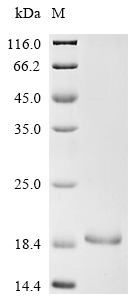Recombinant Mouse Neuron navigator 3 (Nav3) gets produced in an E. coli expression system. The protein includes a partial sequence spanning amino acids 77 to 184. An N-terminal 6xHis-tag is attached to help with purification and detection. SDS-PAGE analysis confirms the protein reaches over 85% purity, which appears to ensure reliable performance in research applications.
Neuron navigator 3 (Nav3) is involved in neuronal development and guidance. The protein seems to play a crucial role in signaling pathways that regulate axon guidance and neural circuit formation. This makes it an important focus in neurobiological research. Understanding how Nav3 functions and gets regulated may provide insights into neural network establishment and its implications in developmental neuroscience.
Potential Applications
Note: The applications listed below are based on what we know about this protein's biological functions, published research, and experience from experts in the field. However, we haven't fully tested all of these applications ourselves yet. We'd recommend running some preliminary tests first to make sure they work for your specific research goals.
E. coli-derived eukaryotic proteins often lack proper post-translational modifications and may form insoluble aggregates or misfolded structures, especially for a neuronal protein like Nav3, which functions in microtubule stabilization and neurite outgrowth. The partial fragment (77-184aa) may not encompass full functional domains (e.g., the calponin homology or cytoskeletal interaction domains critical for Nav3 activity), and no bioactivity data (e.g., microtubule binding assays) are provided. While high purity suggests low contamination, it does not confirm correct folding or functionality. Thus, the protein may not be correctly folded or bioactive without further verification.
1. Antibody Development and Validation
This recombinant Nav3 fragment (77-184aa) can be used as an immunogen for generating antibodies against mouse Nav3, provided it retains linear epitopes. The N-terminal His-tag facilitates purification and immobilization during screening. However, if conformational epitopes are required, the protein's folding must be validated first. For competitive ELISA, the protein may work for specificity tests, but affinity measurements assume proper folding. If misfolded, antibodies may not recognize native Nav3 in physiological contexts.
2. Protein-Protein Interaction Studies
Pull-down assays using this His-tagged fragment are only reliable if the protein is correctly folded. The 77-184aa region might contain interaction domains, but Nav3's binding partners (e.g., microtubules) require specific structural integrity. If misfolded, false-negative or non-specific interactions may occur. Prior validation via circular dichroism or functional assays is recommended to ensure the fragment's native conformation.
3. Structural and Biochemical Characterization
This application heavily depends on correct folding. Techniques like circular dichroism or dynamic light scattering require a homogeneous, properly folded protein. The high purity (>90%) is suitable, but E. coli expression may yield non-native structures. If misfolded, data on secondary structure or stability will be misleading. Use is only advised after confirming folding via biophysical methods.
4. ELISA-Based Binding Assays
The fragment can function as a capture/detection reagent if correctly folded. The His-tag allows oriented immobilization, but binding kinetics studies (e.g., with interactors like microtubule-associated proteins) require a bioactive protein. If misfolded, binding results may not reflect physiological interactions. Screening assays should include controls for folding validation.
Final Recommendation & Action Plan
Given the uncertainties, it is critical to first validate the protein's folding and bioactivity before any application. Recommended steps include: (1) performing circular dichroism spectroscopy to assess secondary structure integrity against known Nav3 domain profiles; (2) conducting a microtubule binding or stabilization assay (e.g., using tubulin polymerization tests) to confirm bioactivity, as Nav3 is a microtubule-associated protein; and (3) using size-exclusion chromatography to check for aggregation. If validation fails, consider alternative expression systems (e.g., mammalian cells) for proper folding. Until verified, applications like protein-interaction studies or structural analyses should be interpreted with caution, while antibody development may proceed with disclosures about potential linear epitope limitations.






